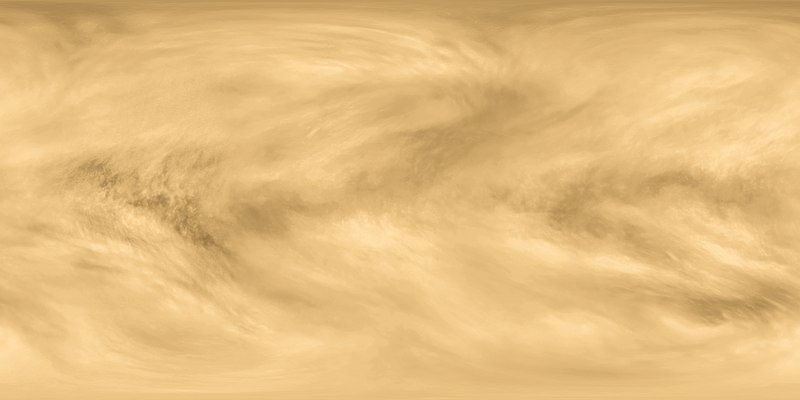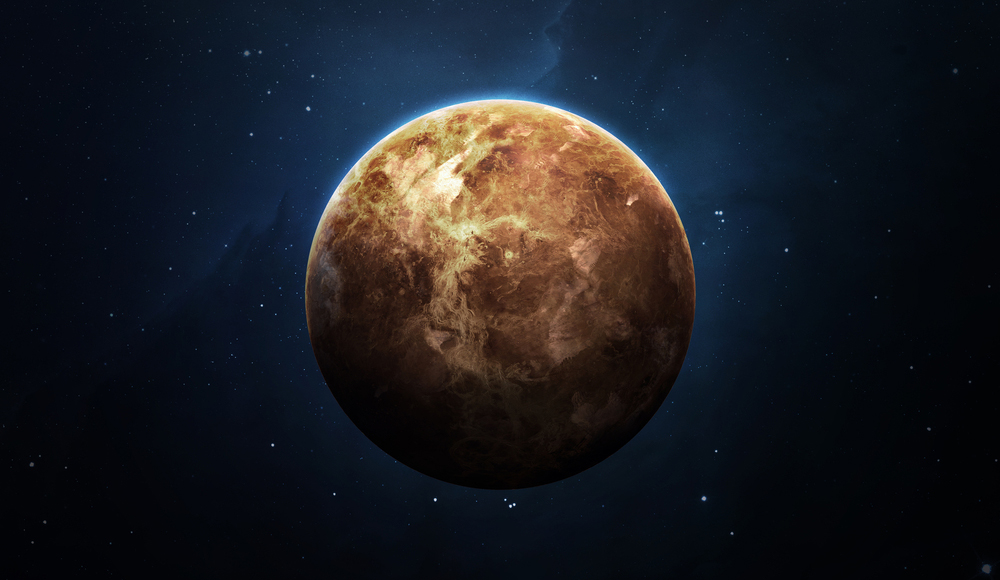Life Signature in Venus’s Atmosphere: Genuine or Not?
Last fall the announcement that phosphine was discovered in Venus’s upper atmosphere stunned internet science geeks.1 This announcement generated over 4,700 news stories around the world. 2 The reason why is that many astronomers consider phosphine to be a signature for the existence of life. Is the signature genuine? Have scientists discovered life on Venus?
Phosphine Discovery Claim
Phosphine is a gas. It is a phosphorus atom bonded to three hydrogen atoms (PH3). On Earth, phosphine is emitted by certain microbes and as fumigants from industrial sources.
Between 50 and 65 kilometers above Venus’s surface, the atmospheric pressure and temperature approximate those of Earth’s surface. (It is not so on Venus’s surface, where the average temperature is 864°F.) It was at this height above Venus’s surface that a team of 19 astronomers led by Jane Greaves claimed to have detected phosphine. The detection, according to Greaves’ team, could be an indication that microbes exist in Venus’s upper atmosphere since nonbiological routes to producing phosphine in Venus’s upper atmosphere, though not impossible, are challenging.
Greaves and her colleagues used the James Clerk Maxwell Telescope (JCMT) in Hawaii to observe a spectral line at millimeter wavelengths where both phosphine and sulfur dioxide (SO2) absorb light. Follow-up observations with the Atacama Large Millimeter Array (ALMA) led them to announce last September that they found phosphine in Venus’s upper atmosphere at an abundance level of 20 parts per billion.

Credit: Solar System Scope, Wikimedia Commons
Phosphine Discovery Rebuttals
I wrote about the possibility of life existing in the upper clouds of Venus exactly one month before Greaves’ team announced their discovery.3 I explained why, outside of Earth, Venus’s upper clouds provide the most “life-friendly” locale in the solar system. I also explained how microbes from Earth have been transported to Venus’s upper clouds by natural means. However, Venus’s upper atmosphere lacks the resources to sustain microbial metabolism and offers no protection from deadly solar and cosmic radiation. At best, all researchers can hope to find in Venus’s upper atmosphere are the remains of Earth life, remains that will be at an extremely low abundance level.
When I first learned of the phosphine detection, I was skeptical. Phosphine abundance at 20 parts per billion seemed too high. Furthermore, a detection level of 20 parts per billion based on just one spectral line that is very close to a sulfur dioxide line, in my opinion, made the detection marginal. Greaves’ team came close to acknowledging the marginal nature of their detection by noting in their paper that “other PH3 spectral features should be sought.” 4
It is the nature of science that discoveries will be tested and reanalyzed—even by the same researchers. The first published critique in the scientific literature of the claimed phosphine discovery came from a team of 26 astronomers led by Geronimo Villanueva.5 These astronomers independently calibrated and analyzed Greaves’ team’s ALMA data using different interferometric analysis tools. In all cases, they observed no evidence for phosphine.
A second response—on the same day—came from 10 astronomers that included Greaves and was led by Thérèse Encrenaz. They published results online of their search for possible spectral signatures of phosphine at infrared wavelengths. 6 Their measurements established an upper limit (at a 99.7% confidence level) on the abundance of phosphine in Venus’s upper atmosphere of only 5 parts per billion. Clearly, the earlier detection claim at 20 parts per billion was, at best, a serious overestimate.
Third, in an online response to Villanueva, 10 of the 19 astronomers who were part of the first Greaves team reported on their reanalysis of their data.7 Reanalysis of their ALMA data suggested an average phosphine abundance in Venus’s upper atmosphere of 1–4 parts per billion. This measure is reconcilable with their JCMT detection of 20 part per billion only if there is a factor of 10 temporal variation in Venus’s upper atmosphere phosphine abundance—a highly unlikely outcome. In their conclusion, the ten astronomers wrote that their measured values were “at the limit of observatory capabilities.”8
In a fourth critique a month later, a team of five astronomers led by Ignas Snellen conducted an independent reanalysis of Greaves’ team’s data.9 They processed the data using the same methods employed by Greaves’ team and concluded that the published “ALMA data provide no statistical evidence for phosphine in the atmosphere of Venus.” 10
Fifth, in the February 1 issue of Astrophysical Journal Letters four astronomers led by Alex Akins presented the most detailed reanalysis of the Greaves team’s data. 11 First, they explained that even if phosphine were being released into Venus’s atmosphere, astronomers should not expect to measure any significant amount. Venus’s known atmospheric chemistry will rapidly photochemically destroy any phosphine that is released.
Akins’ team then re-reduced the ALMA observations of Greaves’ team following both the initial and revised calibration procedures used by Greaves and her colleagues. Though Akins’ team did note a spectral feature that could be a phosphine spectral line in the narrowband data using the initial calibration procedures, they could not find the spectral feature in the narrowband data using the revised calibration, nor could they find it in the wideband data.
What to Make of Venusian Phosphine
These five published rebuttals to the “discovery” of phosphine in Venus’s upper atmosphere are all strong enough to conclude that phosphine has not been discovered in Venus’s upper atmosphere. Thus, the solar system’s most “life-friendly” location outside of Earth still measures to be sterile.
Yet, I do not believe that it is completely sterile. When large meteorites strike Earth, microbes on Earth get ejected into interplanetary space. Many of these microbes get transported to Venus’s upper atmosphere. However, though the temperature and pressure conditions 50–65 kilometers above Venus’s surface are similar to those on Earth’s surface, the chemical conditions are not. The chemistry in Venus’s upper atmosphere is hostile to even extremophile (an organism living in extreme conditions) microbial life. Hence, what will be present in Venus’s upper atmosphere are the remains of microbes rather than viable microbes. These remains will result in little, if any, biogenic phosphine in Venus’s upper atmosphere—probably no more than 1 part per billion.
Given that microbes on Earth have been transported to Venus’s upper atmosphere, it is inevitable that chemical signatures of the remains of Earth’s life will be found there. However, discovering such signatures will be challenging. It will take a new generation of advanced telescopes to reliably detect the chemical signatures of life’s remains at about 1 part per billion or less. When those detections are achieved, they will testify to the abundance, diversity, and longevity of life that God has created on Earth.Featured image: Artist’s Rendition of Venus Sans Atmosphere Based on Radar Reflection Data
ENDNOTES
- Jane S. Greaves et al., “Phosphine Gas in the Cloud Decks of Venus,” Nature Astronomy 4 (September 14, 2020), doi:10.1038/s41550-020-1174-4.
- Editorial, “Venus News Trap,” Nature Astronomy 4 (October 2020): 909, doi:10.1038/s41550-020-01240-9.
- Hugh Ross, “Is Life Possible in the Upper Clouds of Venus?,” Questions from Social Media (August 14, 2020).
- Greaves et al., “Phosphine Gas.”
- Geronimo Villanueva et al., “No Phosphine in the Atmosphere of Venus,” eprint arXiv:2010.14305 (October 28, 2020), https://arxiv.org/abs/2010.14305.
- T. Encrenaz et al., “A Stringent Upper Limit of the PH3 Abundance at the Cloud Top of Venus,” Astronomy and Astrophysics: Letters 643 (November 2020): id. L5, doi:10.1051/0004-6361/202039559.
- Jane S. Greaves et al., “Re-analysis of Phosphine in Venus’ Clouds,” eprint arXiv:2011.08176 (November 16, 2020), https://arxiv.org/abs/2011.08176.
- Greaves et al., “Re-analysis of Phosphine.”
- I. A. G. Snellen et al., “Re-analysis of the 267 GHz ALMA Observations of Venus. No Statistically Significant Detection of Phosphine,” Astronomy and Astrophysics: Letters 644 (December 20, 2020): id. L2, doi:10.1051/0004-6361/202039717.
- Snellen et al., “Re-analysis of the 267 GHz.”
- Alex B. Akins et al., “Complications in the ALMA Detection of Phosphine at Venus,” Astrophysical Journal Letters 907, no. 2 (February 1, 2021): id. L27, doi:10.3847/2041-8213/abd56a.






